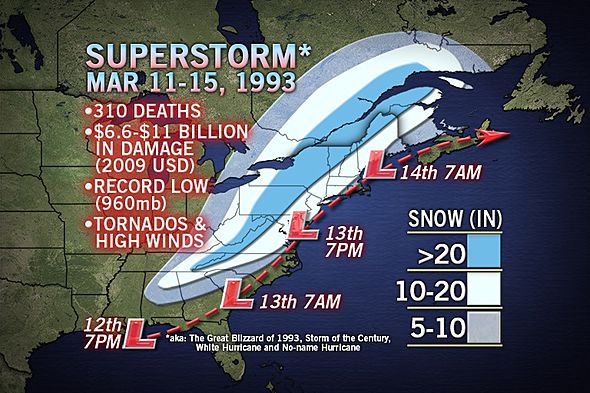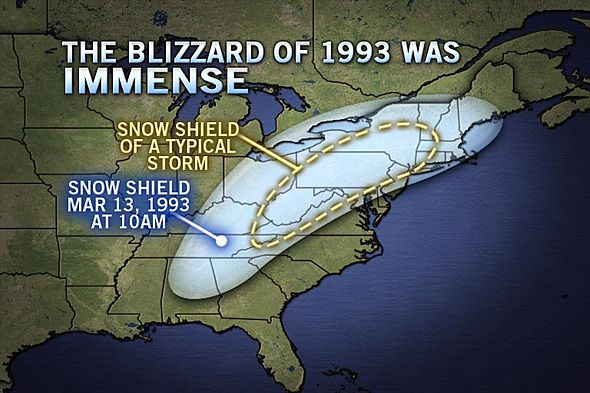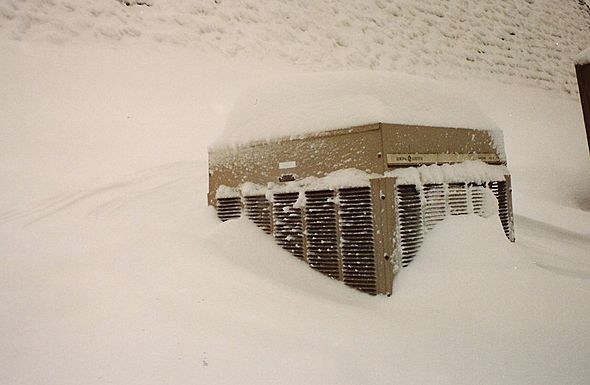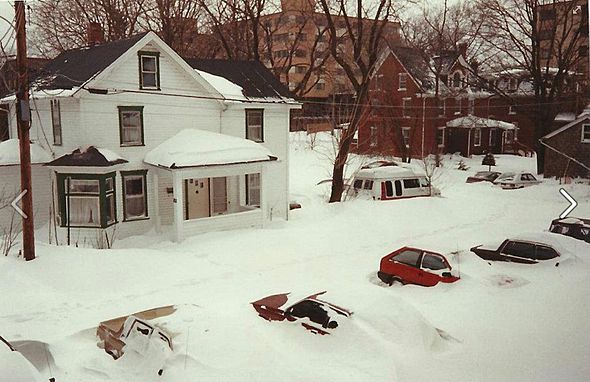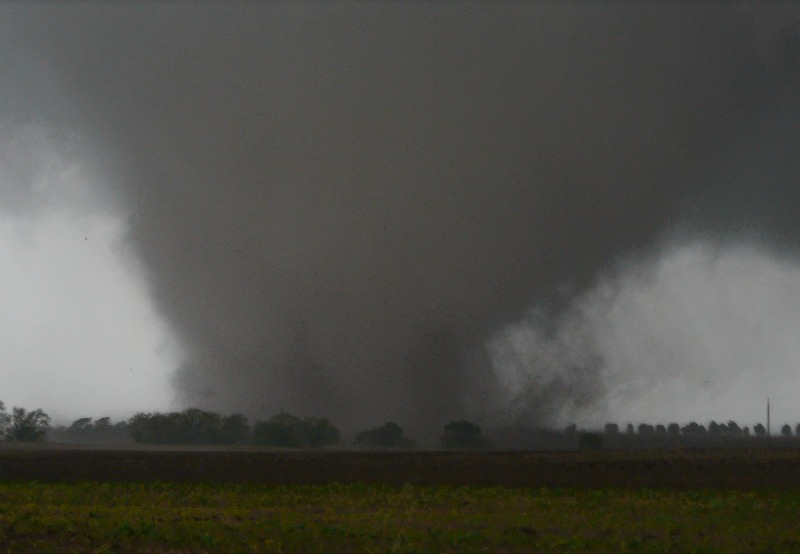Blizzard of '93: Hundreds Killed, Two Dozen States Impacted

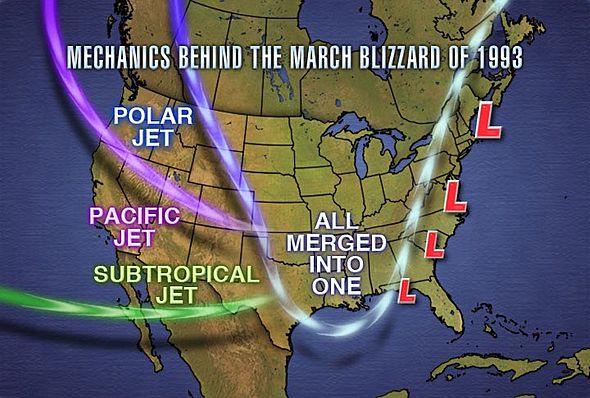
This article was provided by AccuWeather.com.
During the first few days of March 1993, meteorologists at AccuWeather stared in awe of weather patterns that seemed to be pointing toward the potential for a monster storm for the eastern third of the nation a week later.
Map discussions (gatherings of dozens of meteorologists at multiple shifts) in the following days focused on the potential storm, and the discussions were lively to say the least.
By the end of the week, the meteorologists were looking at the jaw-dropping likelihood of a worst case scenario unfolding.
The storm spanning March 12-14, 1993, would unfold as arguably the worst winter storm and blizzard of the 20th century for the Eastern states. While at a smaller regional level, storms such the Ash Wednesday Storm of 1962 and the New England Blizzard of 1978 may have been worse, this one, for its size and strength, may truly sit on the top of the heap in terms of population affected (over 140 million).
The "Storm of the Century" and "Blizzard of '93," as it is often referred to, took the lives of over 300 people from Cuba to the U.S. and Canada and included four dozen lives lost at sea due to massive waves and squalls. Waves as high as 65 feet occurred in the Atlantic Ocean off the coast of Nova Scotia, Canada.
In today's dollars, losses from the storm would cost around $7 billion. In the U.S., over two dozen states were touched by the storm. The storm directly or indirectly impacted approximately 40 percent of the population of the U.S. Hundreds of schools were closed for days (some for a week), and millions of people couldn't get to work in the wake of the storm.
Get the world’s most fascinating discoveries delivered straight to your inbox.
The storm produced an extremely rare, massive swath of 1- to 3-foot snowfall. When combined with wind gusts of tropical storm to hurricane force, it brought drifts as high as single-story homes in the Appalachians.
In a dozen states, emergencies were declared. Unnecessary travel was banned for days in some states and communities. Every major airport on the East Coast was closed at one time or another by the storm's snow, wind or severe thunderstorms. Hundreds of roofs failed under the weight of the snow.
Strong winds and in some areas wet snow from the storm disrupted electrical power for varying durations to millions of homes and businesses. Over most of the central and northern Appalachians, the snow was more powdery in nature and did not adhere to trees and power lines. Power restoration in some areas was hindered by massive drifts and strong winds in the wake of the storm.
Peak gusts included 71 mph at La Guardia Airport, N.Y.; 81 mph at Boston, Mass.; 90 mph at Myrtle Beach, S.C.; and 101 mph at Flattop Mountain, N.C. A sampling of snowfall amounts included 10 inches at New York City; 13 inches at Washington, D.C., Boston, and Philadelphia; 20 inches at Chattanooga, Tenn.; 25 inches at Pittsburgh, Pa.; 27 inches at Albany, N.Y.; 35 inches at Lincoln, N.H.; 44 inches at Snowshoe, W.Va.; and 50 inches on Mount Mitchell, N.C.
While some snow fell to the central Gulf Coast, in the Deep South and in part of the tropics, it was a thunderstorm squall line that caused disruptions and damage, while strong winds also brought storm surge to the west coast of Florida. Damaging storms reached as far south as Cuba and Mexico.
Nasty cold followed the storm for several days and added to the hardship for those without power. Despite being the middle of March, snow lingered on the ground for a week or more in some areas.
Closer to the coast, the snow became progressively more wet and changed to rain, while strong winds pushed ocean water onshore, leading to coastal flooding.
In some states the National Guard was called in for assistance. In some rural areas, giant dump truck-sized snowblowers were brought in to clear roads in the days following the storm. In some communities, where there was too much snow to plow, pay loaders scooped up the snow to make a path and hauled it away.
The storm occurred before widespread use of the internet, cell phones and social media.
According to Evan Myers, Senior Vice President and Chief Operating Officer of AccuWeather, Inc., "The nature of the storm was accurately forecast days in advance. Followers of our radio, TV and newspaper affiliates, as well as special clients were well informed."
Chief Meteorologist Elliot Abrams was the first to tip off radio listeners about the potential storm over a week ahead of time in the Boston, New York City and Philadelphia markets.
Senior Meteorologist and Northeast Weather Expert Dave Dombek stated that AccuWeather aired days in advance that roads would be closed due to the severity of the storm.
"It was one of the rare times that we were able to be that bold in a forecast, without hesitation and knew we would be right," Dombek said.
Senior Vice President Joe Sobel was traveling in the days prior to the storm.
"I recall hearing references on radio stations that broadcast our forecasts that a storm of biblical proportions was on the way," Sobel stated.
The saga of millions during the granddaddy of snowstorms for the region will be passed down to generations.
Many meteorologists and support staff, who are still employed at AccuWeather to this day, worked long, hard hours leading up to, during and following the storm, serving the media and special clients. Some worked nearly non-stop during the storm and chose to sleep for a few hours at work or at a nearby hotel. A number of meteorologists chose to walk home after their shift to see to their families' safety. By the evening hours that Saturday, snow drifts were chest deep in some areas surrounding State College, Pa. There were no vehicles operating. Winds were gusting to 50 mph with near zero visibility at times and RealFeel® temperatures near zero. Some of the walks are 30 minutes or more on a sunny, calm day.
One of the Accuites who chose to walk (a couple of miles) home was Expert Senior Meteorologist Dave Bowers. You might say, "So what? Others did this. What's the big deal?" Well you see, Dave is an amputee and has been so since early childhood. The challenge of getting around on crutches your whole life is one thing, but to do so with one leg, on crutches in a severe blizzard is off the scale. "I had to pole vault over some of the drifts leading to my home outside of town," Bowers said. That is why colleagues at AccuWeather call him "Dave Bowers, The Tower of Weather Power."
Senior Meteorologist Dave Samuel, then a high school student, was amazed at how quickly the snow piled up in the Lake Ridge, Va., area. "The storm marked an end of a huge snow drought in the Washington, D.C., area that reached back to 1988," Samuel said, "I was also upset that we missed 3 feet of snow just to our west."
Jim Rourke, a meteorologist in the AccuWeather.com Climatology Department, was a paperboy in March of 1993. "It was the only time in five years that we did not deliver the paper for one day. As a 13-year-old, I made a lot of extra money shoveling people out days after the storm had passed."
Expert Senior Meteorologist Paul Pastelok, recalls being exhausted after working nearly 25 hours straight with only an hour nap at work. "The morning after the storm, Elliot Abrams, who also racked up mega hours that weekend, sent me on a mission to round up food from the only restaurant open in town. I used a path for emergency vehicles and had to use a side door to get into the restaurant, since the main door was blocked by a massive drift."
Evan Myers, who lived only a few blocks away from AccuWeather's headquarters in State College, put people up in his home during the storm. "It seemed more like a storm in the dead of winter in our area with dry, powdery snow. In my neighborhood, I recall plows not keeping up with the storm and getting stuck in the snow accumulating at a rate of 2 to 4 inches per hour."
Other Stories of Interest: Why Was it the Storm of the Century? More Storm of the Century Memoirs
Sources of information for this story include AccuWeather.com Forensics, the National Oceanic and Atmospheric Administration (NOAA), The National Climatic Data Center (NCDC) and the Associated Press (AP).
AccuWeather.com. All rights reserved. More from AccuWeather.com.
The only sure thing about weather forecasts is that they’re wildly different all over the planet. Test your knowledge on the wild ranges in temperature, precipitation and more.
Extreme Weather Facts: Quiz Yourself


